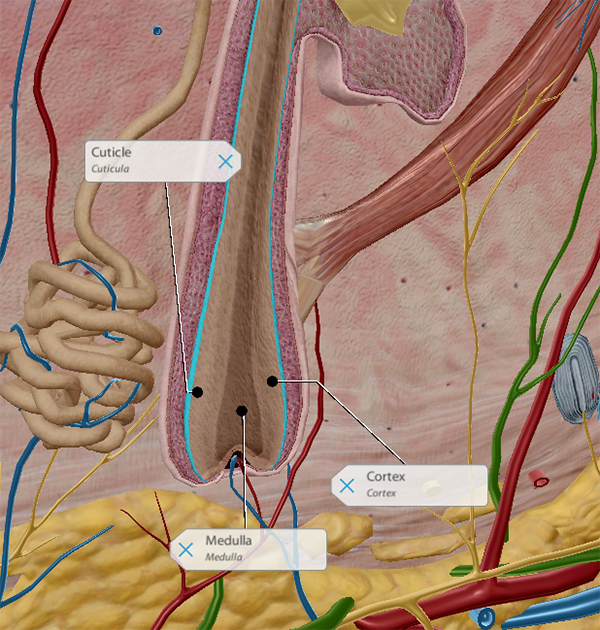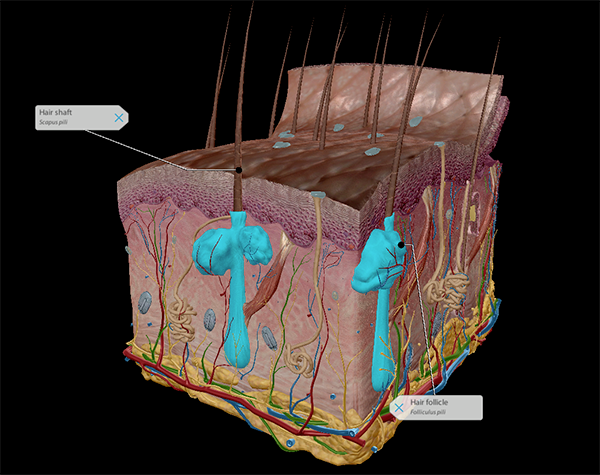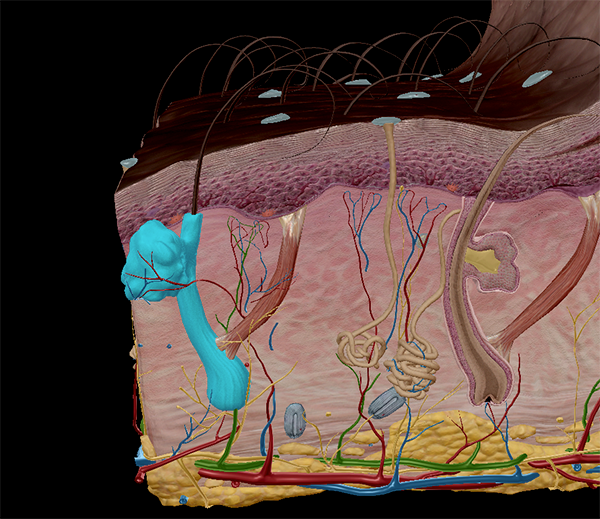Let's Untangle This: All About Hair
Posted on 6/29/22 by Laura Snider
Shampooing, conditioning, curling, straightening, trimming, coloring, shaving, plucking, waxing...it can take a lot of effort to groom the hair on one’s head and body. But how much do you know about the anatomy of hair? What is it made of? How does it grow? How does it get its color? Read on to find out!
Your hair is only mostly dead
A hair has two parts: the root and the shaft. The root is the living part of the hair that sits in the dermis, the middle layer of the skin. The root is surrounded by the follicle, which is typically attached to a sebaceous (oil) gland in the skin. All told, your skin has about 5 million hair follicles, and around 100,000 of these are on your scalp.
Within the follicle, stem cells in the root of the hair divide rapidly. As more new cells develop, the older ones are pushed upward and form the shaft of the hair, the part that eventually sticks up above the epidermis. As a hair grows towards the surface of the epidermis, the cells composing it are cut off from nourishment and die.
We usually say that hair is “made” of a protein called keratin—that’s a bit of a simplification. As hairs become part of the shaft, they undergo a process called keratinization, in which they become filled with keratin. So, technically, instead of being made up of pure keratin, hair is made up of dead cells that are filled with and surrounded by keratin.
Hairs generally have two or three layers. The innermost layer, the medulla, is only present in some hairs. The cortex is the middle layer, and it composes most of the hair shaft. It also contains much of the melanin that gives hair its color. The outermost layer is called the cuticle. Though the cuticle is only a single layer of cells, those cells are arranged in a scale-like way to protect the cortex and medulla.
 The parts of a hair. Image from Human Anatomy Atlas 2022+.
The parts of a hair. Image from Human Anatomy Atlas 2022+.
Straight and curly hair have different follicle shapes
Did you know that in addition to having different appearances, straight and curly hair have different shaped follicles? The shape of the hair follicle determines the shape and structure of the cortex and medulla of the hair shaft.
Learn more using the 3D skin microanatomy models in Human Anatomy Atlas 2022+.
The follicles that give rise to straight hair are roughly oval-shaped in cross-section.
 Shaft and follicle shape: straight hair. Image from Human Anatomy Atlas 2022+.
Shaft and follicle shape: straight hair. Image from Human Anatomy Atlas 2022+.
The follicles that give rise to curly hair, on the other hand, are curved in shape. As you can see in the image below, they have one main c-shaped curve, as well as a smaller, secondary curve at the bottom.
 Shaft and follicle shape: curly hair. Image from Human Anatomy Atlas 2022+.
Shaft and follicle shape: curly hair. Image from Human Anatomy Atlas 2022+.
You have two types of hair
Did you know that there are two types of hair found on the human body?
Vellus hairs are the short, soft, fuzzy hairs found almost everywhere on the body. Their primary purpose is to provide insulation. Terminal hairs, which are coarser and darker in color than vellus hairs, are the ones found on your head.
Okay, there is actually a third type of hair: lanugo hairs, but they’re just for babies. These hairs develop in utero but are usually shed between 36 and 40 weeks and then replaced by vellus hairs.
Also, during puberty, hormones cause vellus hairs on some areas of the body to be replaced by terminal hairs. That’s right—beard, armpit, and pubic hairs are terminal hairs! If that’s true, then why can’t you grow your armpit hair to Rapunzel levels? Armpit and pubic hair has a growth period of a couple of months, while the hair on your head generally has a growth period of 2 years or more.
Speaking of which...
How hair grows
The average rate of hair growth is 0.5 inches (1.25 cm) per month. This means that the average person’s hair can grow about six inches a year!
There are three phases of hair growth. The first is the anagen, or active growing, phase. Cell division in the hair’s root is in full swing, fed by blood vessels in the papilla at the bottom of the follicle. Anagen is the longest phase of hair growth. It can last years for the hairs on your head, while hairs on other areas of the body tend to have shorter anagen periods.
During the second phase, catagen, hair growth slows down. Cell division stops, blood flow is cut off, and a “club hair” is formed as the follicle prepares to enter its resting period. This phase usually lasts about 2–3 weeks.
The final phase, telogen, is when hair growth stops and the hair follicle is “at rest.” Telogen usually lasts for about 3 months. When a new hair begins to grow, the old (club) hair falls out.
Humans typically shed between 50 and 100 hairs a day. Fortunately, we don’t lose all of our hairs at the same time. Each hair grows according to its own cycle—that is, it undergoes the phases of growth individually instead of coordinating with its neighbors.
Hair gets its color from melanin
You may recognize melanin as the pigment that gives skin its color. Well, it’s responsible for hair color too. There are two types of melanin found in hair: eumelanin, which makes darker colors, and pheomelanin, which makes lighter colors. Cells called melanocytes, located adjacent to the hair follicle, inject the keratinized cells of the hair shaft with melanin.
Ever wonder why people’s hair goes grey (or white) as they age? Melanin production decreases with age, and less melanin means less pigmentation in the hair. Nishimura et al. (2005) suggested that melanocyte stem cells might fail to properly maintain the population of melanocytes as the body ages.
Be sure to subscribe to the Visible Body Blog for more anatomy awesomeness!
Are you a professor (or know someone who is)? We have awesome visuals and resources for your anatomy and physiology course! Learn more here.
Additional Sources:
- Khan Academy: Where do our hair and nails come from?
- Medical Daily: 8 Strange Facts About Body Hair You Probably Didn't Know
- Terminal Hair
- The Biology of Hair
- What Are Keratinocytes?
- KidsHealth from Nemours: Skin, Hair, and Nails (for Parents)
- Sci Show: How Does Hair Know When to Stop Growing?
- Speaking of Chemistry: Why Does Your Hair Turn Grey?
- Everyday Mysteries: Why does hair turn grey?




